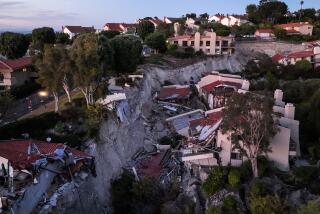Crystals can help predict volcano eruptions, scientists say
- Share via
Scientists dissecting the remains of the disastrous 1980 explosion of Mt. St. Helens in Washington state say that crystal formations trapped in volcanic rocks hold important clues about when a magma-loaded mountain is about to blow — a discovery that could help volcanologists make more accurate predictions about future eruptions.
The findings, published in Friday’s edition of the journal Science, link the movement of underground magma to earthquakes, gas emissions and other warning signs that are more accessible to experts who monitor active volcanoes above ground.
Volcanic eruptions, like earthquakes, are notoriously difficult to predict. Volcanoes are able to stay dormant for decades, even centuries, before suddenly exploding and wreaking havoc around them. The 2010 eruption of Iceland’sglacier-bound Eyjafjallajokull volcano after nearly 200 years of peaceful slumber filled the skies with ash, grounding flights into and out of northern Europe.
An imminent eruption can often be picked up if seismometers in the area detect the smaller earthquakes that precede an eruption. This is what occurred in the lead-up to the Mt. St. Helens event, allowing officials to evacuate the surrounding areas before the eruption — which saw the crumbling of the mountain’s north slope, 57 deaths, ash deposited in 11 states and more than $1 billion in damages at the time. Smaller eruptions continued through 1986; the volcano was last active in 2008.
But scientists weren’t able to firmly link the signs they see above ground with what’s happening below, said Olivier Bachmann, a volcanologist at the University of Washington who was not involved in the study.
“It is an ongoing challenge,” Bachmann said. “I think this paper is a step forward toward trying to better understand this link.”
To find out what was happening beneath the surface, scientists looked at a type of crystal that forms in the magma when it’s underground. These so-called orthopyroxene crystals can be magnesium-rich or iron-rich, and their chemical qualities depend on the magma around them — how hot it is, how much water or how many gas bubbles it contains, what sort of pressure the molten rock is under, and what the magma is made out of in the first place.
“Crystals are a bit like a book: If you know your alphabet you can read the book,” said volcanologist Kate Saunders of the University of Bristol in England, who led the study. “They provide a record for what happens. If we know what to look for and how to read them, we can work out the processes that formed the magma and how long it took these processes to occur.”
The crystals in this case are typically about 100 to 500 microns in diameter, roughly the thickness of a human hair. They form what look like tree rings, and just as tree rings can tell ecologists what the environment was like, the differences in these tiny mineral rings can tell scientists about the surrounding magma.
If scientists saw a magnesium-rich deposit in the crystal, for example, it was likely there had been a fresh charge of new magma into the reservoir within the volcano. An iron-rich layer could indicate that gas and vapor trapped in the magma had begun escaping. Both of these scenarios are thought to trigger the earthquakes that precede eruptions.
The researchers used electron microscopy to examine 98 crystals and cross-checked the tiny changes in the crystals with the series of volcano-related earthquakes that occurred between 1980 and 1986. They found that the rate of crystal formation seemed to peak around the time the earthquakes began occurring — earthquakes that often preceded the eruptions by several weeks.
“I didn’t expect it to fit so nicely,” Saunders said. “It’s just remarkable.”
With current technology, there’s no easy way to sample underground magma in real time to look for signs of imminent eruptions, Bachmann pointed out. But finding a way to tell when a volcano is likely to explode remains the ultimate goal, she said.
“If we can find a certain chemical signature that definitely heralds an eruption and we can see that also in a monitoring signal, that would be the Holy Grail,” Saunders said.







